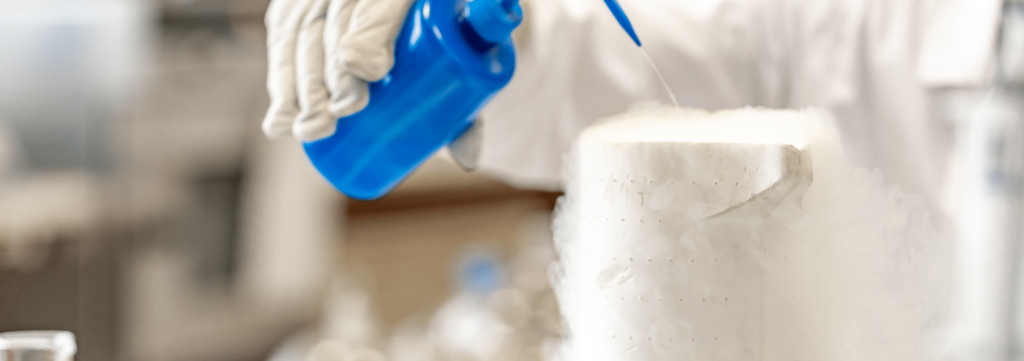Cryopreserved embryos: the hidden tragedy
A recent study looks at the number of surplus human embryos from IVF techniques stored under cryopreservation in the UK. According to this research, their number is the highest since records began, which began in 1991 by the United Kingdom’s Human Fertilization and Embryology Authority (HFEA). The work presents a quantitative analysis of the data […]

A recent study looks at the number of surplus human embryos from IVF techniques stored under cryopreservation in the UK.
According to this research, their number is the highest since records began, which began in 1991 by the United Kingdom’s Human Fertilization and Embryology Authority (HFEA).
The work presents a quantitative analysis of the data from 1991 to 2019 provided by the HFEA, as well as a comment on the trends observed within this data, which show that, at least, 130,000 human embryos that remained cryopreserved have been discarded in the Kingdom United since 1991.
Currently, 500,000 of these human embryos remain frozen in liquid nitrogen tanks, most of them destined for destruction.
The unfortunate Warnock Report, published in 1984, which defined the “pre-embryo” as an embryo less than 14 days old, however, attributed to it a special moral status, which prevents its direct elimination in cases of supernumerary embryos obtained by insemination. vitro that are not going to be implanted in their mother’s uterus.
The scientific evidence available today has shown that the term “pre-embryo” lacks scientific foundation, given that there is no change in nature in the early embryo that allows us to speak of different entities depending on the maturation state.
The confirmation of the implementation of a development program marked by the genetic information of the embryo itself and the epigenetic evolution that accompanies it, allows the existence of an individual of the human species to be identified from the moment of fertilization. Trying to attribute a different status to it – the “pre-embryo” – depending on the maturation moment, as the aforementioned Warnock Commission did, is arbitrary and indefensible based on the scientific evidence available today.
As we have previously published in our Observatory, a newspaper article expressed concern that, in Spain, 60,005 embryos are in a “situation of abandonment” because their fate has not been defined. But it is much more serious that 668,082 of them – according to recorded data, although in reality there may be many more – remain cryopreserved, destined, mostly, for their destruction, either by promoting it directly or by doing so to use their cells in research.
Some promoters of assisted reproduction techniques raise the contradiction that the laws protect these embryos by preventing their direct destruction and, yet, free abortion has been normalized in many of these countries in the first trimester of pregnancy or even later, without requiring any safeguard of the rights of these aborted embryos, unlike those produced in vitro, which must be offered different treatment.
Why should hundreds of thousands, millions worldwide, of leftover embryos from assisted reproduction accumulate, subjected to expensive cryopreservation procedures, while other embryos, those deliberately aborted, can be discarded without any contemplation?
This insurmountable contradiction shows the utilitarian background that promotes contempt for human life in its most unprotected and dependent form.
It is bioethically unacceptable to end human lives through induced abortion, but it is no less acceptable to generate huge quantities of embryos destined mostly for destruction as a consequence of in vitro fertilization. But yes, after expensive cryopreservation processes that keep these embryos in an undignified situation for years, before their definitive destruction. According to the aforementioned article, “only 8% of the families interviewed had the intention of making new pregnancy attempts with the embryos left over after one year.”
The alarms over the accumulation of cryopreserved human embryos – which concerns us now is not the first – have not managed to reverse this tragic trend, which continues to increase the barbarity of millions of human beings in an embryonic state, stored in liquid nitrogen freezers, which Nobody seems to care about them, and they await the moment – inevitable for most of them – of their destruction.
Attempts to limit the number of embryos obtained in these techniques collide with the interests of the clinics involved, which aim to increase their success rates by obtaining more embryos, on which their lucrative business largely depends.
The new possibilities of preimplantation genetic diagnosis techniques allow the best specimens to be selected from a multitude of embryos, in a eugenic exercise that aggravates the problem.
In another article from our Observatory, and in reference to a work published in the magazine Nature on the occasion of the fortieth anniversary of the birth of the first girl conceived by in vitro fertilization, Louise Brown, assisted reproduction has not ceased to generate controversy in these four decades: thousands of discarded embryos, choice of sex, designer babies, tanks full of frozen embryos with an uncertain future, 60-year-old women who decide to be mothers, surrogacy, research with embryos…
Something is not working, but it does not seem to matter much to the population that continues to resort to assisted reproduction techniques in increasing numbers, with our country in the lead.
Julio Tudela – Life Sciences Institute – Bioethics Observatory – Catholic University of Valencia
Related

The Family: A School of Love, Forgiveness, and Hope
Laetare
25 April, 2025
3 min

Pope Francis: Leadership That Transforms Through Service
Javier Ferrer García
25 April, 2025
4 min

The heart of the Church beats between mourning and hope
Exaudi Staff
24 April, 2025
2 min

What is a Conclave? The Process That Elects the New Pope
Exaudi Staff
24 April, 2025
7 min
 (EN)
(EN)
 (ES)
(ES)
 (IT)
(IT)

